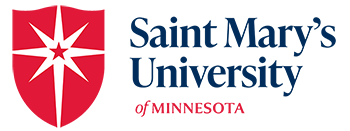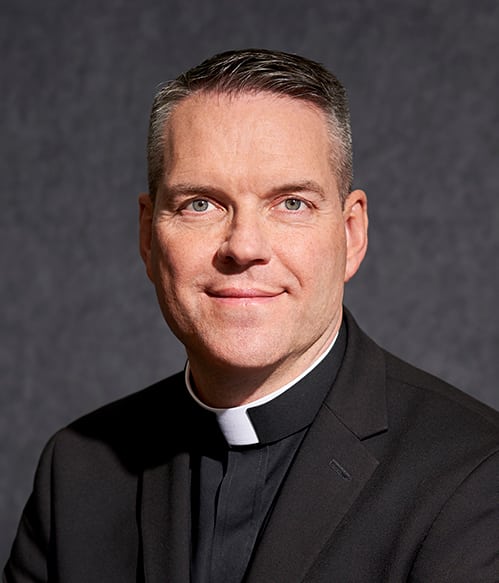Saint Mary's Newsroom
Campus ConnectionAn update from the president to alumni and parents

Advising programming by sharing experiences
Sue Fangel M’09, ’19 knows Saint Mary’s from pretty much every angle: graduate student, nontraditional undergraduate student, undergraduate parent, and alumna. And now she’s using her knowledge — and her vast career experiences in nursing administration — to prepare Saint Mary’s for the students of tomorrow.
Her introduction to Saint Mary’s came while her eldest son, James ’08, was enrolled as an undergraduate on the Winona Campus. At 48, she decided to enroll in the university’s M.A. in Health and Human Service Administration program at the Twin Cities Campus and fulfill a long-standing educational dream.
Deciding on Saint Mary’s started with a web search. “Saint Mary’s was more affordable, convenient, and it resonated with me when I looked at the curriculum,” she said. “It was geared toward what I was looking for, and had a broad spectrum of classes.”
She admits that going back to school again, after 14 years away from the classroom, wasn’t always easy.
“I’ll be honest, my first class was a communication class,” she said. “And if not for that professor, I don’t know if I would have stuck it out. She told me, ‘Don’t worry about it; your experiences in life are going to carry you through this whole program. I’ll teach you how to write’, and she did, and I enjoyed it. I really liked the diversity of the program and the diversity of students in my classes. It was interesting to work and get perspective from social workers, other nurses, and law enforcement.”
Ten years later, when she was 58, Fangel was told a Bachelor of Science in Nursing degree was a requirement of her position as VP chief nursing officer for Saint John’s and St. Joseph’s hospitals in the Twin Cities.
Again, she turned to Saint Mary’s. “I thought, ‘Why would I even doubt where I’m going to go?’ I began the online RN to BSN program the spring of 2018 and did the full program in three semesters.”
She recalls it was an “enlightening” experience. “It’s a good program, and it’s very doable,” she said, adding that she promotes the program within her organization and was honored to serve on the RN to BSN advisory board.
Her eldest son James graduated from Saint Mary’s in 2008 and her second son Andrew graduated in 2011, both in biology. “They had great experiences and they received a great education,” she said. “They were really set up well. James loved taking genetics from Dr. Dick Kowles M’67, and Dr. Jeanne Minnerath was very instrumental in helping James find his career direction in cytogenetics at Mayo Clinic in Rochester.”
Andrew also started his career at Mayo Clinic and now works at Minneapolis Children’s Hospital as a lab safety and education specialist.
Both James and Andrew met their wives at Saint Mary’s. James’ wife Sophie (Harrison) ’13 studied psychology and currently works for Mayo Clinic, and Andrew’s wife Abby (Lough) ’13 studied education and works for the South Saint Paul School District.
With Sue’s encouragement, James, Andrew, and Sophie followed in her footsteps and also graduated from Saint Mary’s M.A. in Health and Human Service Administration program.
“Saint Mary’s became part of our landscape,” she said.
So when Fangel was asked to be part of the Nursing Advisory Board as Saint Mary’s initiates a B.S. in Nursing program on the Winona Campus this fall, she agreed and is bringing a wealth of career knowledge with her.
As the VP chief nursing officer, she oversees all nursing operations at two hospitals. “All nursing directors and managers report to me, from a gamut of nursing units from the emergency room to maternity to the NICU,” she said. “A lot of my focus is on finance, customer experience, employee engagement, and well being, quality, and patient safety.”
While her job entails everything from inspections, to meeting the changing demographics of her patients, she said everything she does revolves around ensuring the hospitals are providing safe, high quality, and compassionate care to their patients.
Her main goal for Saint Mary’s pending nursing program is, in a nutshell, that it’s successful. “I saw the curriculum, and it’s so exciting that there’ll be another nursing program in the state,” she said. “I love that students can have the whole college experience and be on campus, and that they will be enrolled in the nursing program right away their first year. Saint Mary’s will develop ethically strong and well educated nurses who will come and work in our communities. There’s always a need, particularly in rural healthcare.”
And, as a new member of the Board of Regents, the advisory board of the Schools of Graduate and Professional Programs, she’ll extend her advisory role. “I hope Saint Mary’s will continue to build and grow,” she said. “The university is adding several programs, which is exciting, especially some bachelor’s completion programs. There are a lot of unconventional learners, like I was, out there,” she said.
“This is how I can give back to the university that has given me the opportunity to do the job I’m doing — in the position that I’m in — and for what my sons and their wives have gained in their careers and their lives. It’s just a blessing.”
Faculty promotion congratulations
Saint Mary’s University of Minnesota is proud to announce the following full-time Schools of Graduate and Professional Programs (SGPP) faculty members who were promoted in 2020-21.
John Ebert, professor and director of Data Intelligence and GeoAnalytics program
 Education
Education
Ed.D. in Leadership, Saint Mary’s University of Minnesota
M.S. in Resource Analysis, Saint Mary’s University of Minnesota
B.S. in Geoscience, Winona State University
Dr. Ebert has been an associate professor and director of the M.S. in Data Intelligence and GeoAnalytics program, the Geographic Information Science (GIS) certificate, and the Data Engineering certificate since 2002. In addition to maintaining nearly a full-time teaching load, Dr. Ebert also serves other programs including the marketing undergraduate program and the business intelligence and data analytics graduate program where needed. Dr. Ebert is passionate about the use of geoanalytics in problem solving and enjoys advising and working with graduate students on their research projects. He has presented research at Google headquarters, Minnesota GIS/LIS Consortium, State of Minnesota, Upper Midwest GEOCON, and the Saint Mary’s University of Minnesota Business Intelligence Summit.
Sue Hines, core professor in the Doctor of Education in Leadership program
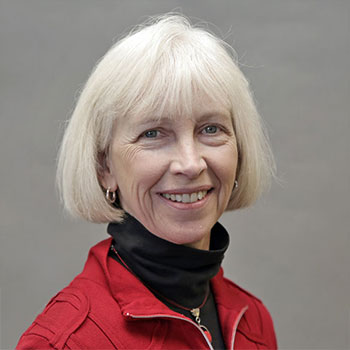 Education
Education
Ed.D. in Leadership, Saint Mary’s University of Minnesota
M.A. in Education, Saint Mary’s University of Minnesota
B.A. in Educational Psychology, Metropolitan State University
Certificate in Veterinary Technology, Argosy University
Dr. Hines’ research interest is faculty development evaluation. Her work has resulted in several publications in peer-reviewed journals including the Journal of Faculty Development, To Improve the Academy, AXIS: Journal of Lasallian Higher Education, and Magna Publications. She has presented her research at numerous national conferences and has received research grants to support her studies. She recently completed and published a nationwide field-testing project to validate her faculty development program evaluation model and intends to co-author a book on the topic.
She provides presentations, workshops, and webinars on topics of adult learning at regional colleges, has served on an advisory board for a local private college, is a past editorial board member for the Journal of International Students, is currently on the editorial board for the Journal of Faculty Development and To Improve the Academy, and is an active member and organizational contributor for the Professional Organizational Development (POD) Network.
Paul Kotz, core professor in the Doctor of Education in Leadership program
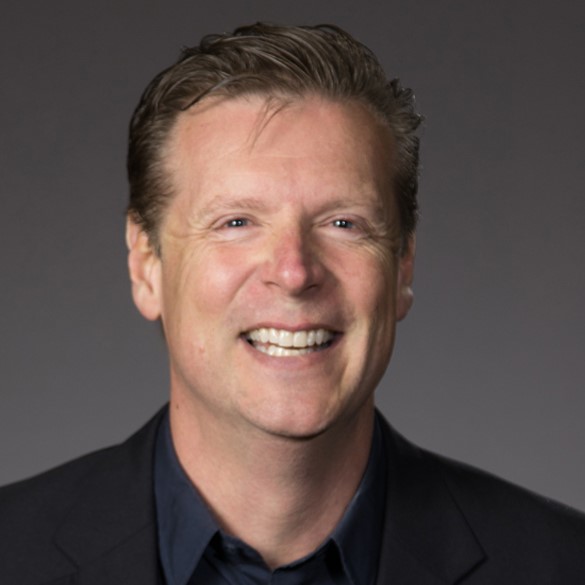 Education
Education
Ph.D. in Philosophy of Education, University of Minnesota
M.Ed. in Work/Community/Family Education, University of Minnesota
B.A. in Mathematics/Quantitative Methods, University of St. Thomas
Dr. Kotz is a career educator with education and business expertise. This includes working with high school, undergraduate, graduate, and doctoral students in the areas of management, leadership, operations, strategy, statistical analysis, and doctoral research preparation. Prior to his teaching career, he was a reinsurance actuary in both life and property casualty insurance. He also served as a manager for customer service at North American Life and Casualty prior to his education pursuits, and department chair for General Education at Anoka Hennepin Technical College.
Dr. Kotz’s teaching philosophy is unique in that many students in his ethics, organizational effectiveness, and statistics courses would say, “I think I’m in a philosophy course,” as he takes a broader view of the mechanics of these disciplines and how it enables value-based decision-making. Currently, he teaches doctoral courses in preparation of literature review, methodology, results, conclusions, and recommendations for business, education, and health care in the Doctor of Education in Leadership program. Dr. Kotz also assists students in preparing research and in the defense of and presentation of dissertations/theses and performance results studies in education, business, national security, leadership, social justice and health care management. This involves working with students over a 3-4 year period to complete their life’s work. Dr. Kotz enjoys writing and has published the following books:
- Kotz, P. E. (2020). Profiles in Kindness: Stories of Inspiration & Everyday Leadership (2nd ed., Vol. 1). Outskirts Press.
- Kotz, P. E. (2018). Something Happened Today: A Collection of the Unexpected (2nd ed., Vol. 1). Outskirts Press.
- Kotz, P. E. (2014). Personality, Gender & Learning Styles: Teaching to Student Aptitudes (1st ed., Vol. 1). Scholars’ Press.
Signe Nestingen, core professor in the Doctor of Psychology in Counseling Psychology program
 Education
Education
Psy.D. in Counseling Psychology, University of St. Thomas
M.A. in Counseling Psychology, Adler Institute, Chicago, Ill.
B.A. Major, Sociology; Minor, Communications, Augsburg College
Dr. Nestingen began teaching at Saint Mary’s in 2007 and began teaching in the doctoral counseling psychology program in 2010. She serves as the director of clinical training, is a core faculty member, and is the mentorship coordinator. Dr. Nestingen teaches doctoral students each semester with a rotating number of classes and must stay current to teach these classes. She also attends community and academic training seminars and presents in both community and academic settings. She has a small clinical practice that she has maintained for more than 30 years, and she sees both individuals and couples in that practice. She has provided consultation for individuals and groups for issues related to the science of human behavior in college counseling centers, educational programs, health care centers, and for small group practices. Dr. Nestingen is active in the Minnesota Psychological Association (MPA) and serves on both the ethics and diversity committees.
Matt Nowakowski, core professor and director of the Doctor of Business Administration program
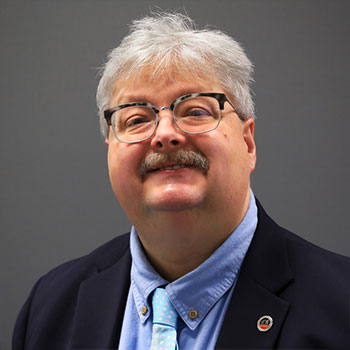 Education
Education
B.S.E. (Biology and History), University of Wisconsin-La Crosse
MBA, Edgewood College, Madison, Wis.
Doctor of Education in Leadership, Saint Mary’s University of Minnesota
Dr. Nowakowski writes and presents on individual resilience and community resilience and was named a Distinguished Lasallian Educator at Saint Mary’s University of Minnesota in 2020. He has presented work at the Academy of Management, Midwest Academy of Management, Southwest Academy of Management, Management and Organizational Behavior Teaching Society, CAEL Conference, International Symposium on Lasallian Research, International Conference on Catholic Social Thought and Business Education, and the Huether Conference. He has published works in MBA Innovation, The Digital Journal of Lasallian Research, and AXIS: Journal of Lasallian Higher Education. Dr. Nowakowski is currently a member of the editorial board of AXIS: Journal of Lasallian Higher Education and is a reviewer for the Academy of Management. He also worked in corporate and customer training at Nicolet Instruments/Thermo Electron Corporation with international assignments in Japan, Sweden, Finland, and Saudi Arabia.
Jerome Shih, core associate professor in the Doctor of Psychology in Counseling Psychology program
 Education
Education
Ph.D., Educational Psychology, University of Minnesota
M.A., Counseling Psychology, University of St. Thomas
Information Systems Analysis and Design Certificate, University of Minnesota
B.A., East Asian Studies, University of Pennsylvania
Prior to joining the faculty in the Psy.D. program, Dr. Shih was employed for more than 10 years as assistant director of University of Minnesota Student Counseling Services. In addition to college counseling, he has worked as a counseling psychologist in community mental health and corporate settings. Dr. Shih has taught for many years as course-contracted faculty in the master’s in counseling and psychological services program at Saint Mary’s, as well as in the counseling and student personnel psychology program at the University of Minnesota.
Zak Mayo, Department of Business and Communication at the College, promoted to associate professor
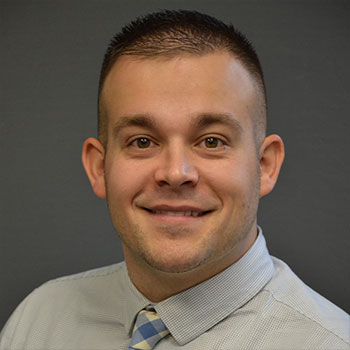 Education
Education
Ph.D. Sport Management, Troy University
M.B.A., College of Business Administration, The College of St. Joseph, Rutland, Vt.
B.S. Sport Administration, School of Health, Human Movement, and Sport, Castleton University, Castleton, Vt.
Dr. Mayo has been a valued colleague and leader, always willing to work for the good of his students and colleagues. He recently joined the Strategic Planning Committee of COSMA (Commission on Sports Management Accreditation), which helps direct and guide the future of the study of sports management. His consulting roles with ESPN, Elite Dribble, and Ensign Athletics allowed him to bring experiences directly to the classroom to benefit students. One of the highlights of his career thus far with Saint Mary’s is his efforts to form a unique partnership with the ESPN X Games. He formalized the agreement with the X Games to bring this experiential opportunity to Saint Mary’s students. He actively recruits, screens, and prepares students for this opportunity. Dr. Mayo was instrumental as a member of the Strategic Initiative No. 3 team as the university built and piloted new pathway programs in business.
Congratulations to these outstanding faculty colleagues.
Saint Mary’s students receive Stay the Course Grant awards
Saint Mary’s University Master of Science in Accounting students Brent Jambor and Sydney Tribbett have each been awarded a $500 Stay the Course Grant from Wiley Education Services, a strategic partner of Saint Mary’s University.
Wiley’s Stay the Course Grants are designed to provide assistance to students during the COVID-19 pandemic so they may “stay the course” by continuing their college careers. Through the strategic partnership with Wiley, Saint Mary’s continues to pursue opportunities that provide access and flexibility to support our students’ needs. The Stay the Course Grant reinforces this commitment.
Join us in congratulating these graduate students on their continued academic pursuits.
In the news
Saint Mary’s athletics was covered in the news quite a bit in recent weeks due to the success of our Cardinal baseball and track and field teams. Here are a few headlines:
- Schultz named All-Conference
- Cardinals win playoff title, earn NCAA bid
- Saint Mary’s season comes to an end
- Saint Mary’s drops NCAA regional in pitchers duel
- Swanson 4×100 relay headed to NCAAs
Saint Mary’s participated in an Inside Higher Ed webinar, during which participants learned how the university successfully migrated course content, archived student data, and implemented a new learning management system campuswide through an aggressive but achievable timeline.
Senior leadership announcement
In our continued efforts to advance our strategic plan, Building a Future Full of Hope 2025, we have two personnel announcements to make. Both support initiative No. 1, Living our Lasallian Catholic Heritage.

Marisa Naryka, Ed.D.
Marisa Naryka, Ed.D., has been named vice president for mission and ministry effective immediately. Dr. Naryka most recently served as assistant vice president for student affairs, a position that brought her to Saint Mary’s University in 2018. She completed her Doctor of Education from Regent University in Virginia Beach, Va. Of particular import to this current position is her dissertation work, titled “The Impact of Mission Formation Programs on Senior Administrators at Lasallian Catholic Institutions in the Midwest District.” Prior to Saint Mary’s, Dr. Naryka held positions as director of residential life and international studies.
Dr. Naryka succeeds Brother Stephen Markham, FSC, Ph.D., who took a medical leave of absence earlier this year. “Dr. Naryka will continue to work closely with students, and she is fully committed to our Lasallian Catholic mission,” said Father Burns. “The fact that her dissertation so clearly and squarely focuses on formation of leadership in Lasallian Catholic universities makes her exceptionally well positioned to take on this role. She also knows our community very well, especially our students, so that she can lead from the center. As Brother Stephen concentrates on his health, we continue to hold him in our thoughts and ask all to join in praying for his renewed healing and full recovery. I also want to take this time to thank Brother Robert Smith, who has served as interim vice president since Brother Stephen took his leave.”

Matthew Gerlach, Ph.D.
To further support and enhance Goal 1 of the strategic plan, Matthew Gerlach, Ph.D., has been appointed as vice president for character, virtue, and ethics and core associate professor of ethics and leadership as well as the director and endowed chair of the Hendrickson Institute. Dr. Gerlach will lead efforts to advance the university’s vision around character education and virtue formation with constant focus on our mission to awaken, nurture, and empower learners to ethical lives of service and leadership. Working with all areas of the university, Dr. Gerlach will pilot opportunities that transform teaching, learning, service, scholarship, and more through both in person and technology platforms that will further develop and highlight Saint Mary’s as a leader in ethics, character, and virtue education.
Dr. Gerlach will also advance the Hendrickson Institute as a resource for the university, greater community, current and emerging leaders, and as a forum to explore ethical principles, models, and issues. He currently serves as dean of the Institute for Lay Ministry at Sacred Heart Major Seminary in Detroit. He has extensive teaching experience in theology and has served in academic administrative positions at several universities as well. Dr. Gerlach will join Saint Mary’s on Aug. 1. He holds a Doctor of Philosophy, Religious Studies, from Marquette University and received his bachelor’s and master’s degrees from the University of St. Thomas.
“Working together, we have made great progress on the strategic plan, and these two leaders will help us continue to build a future of hope and prosperity that further distinguishes Saint Mary’s and showcases our Lasallian Catholic heritage,” said Father Burns. “I am pleased to add that Dr. Gerlach’s position is supported through an endowed chair, made possible by a recent gift from a generous benefactor. This benefactor shared that this investment has been made to promote the focus on ethics that Saint Mary’s is known for but should be even better known for, and will be, as we join this approach to character education and virtue. It sets us apart as a leader in Lasallian Catholic higher education for the good of all.”
Get to know our faculty: Carie Statz, DBA
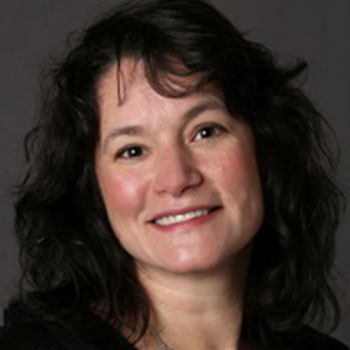
Carie Statz
This month, we are excited to share more about Carie Statz, DBA, associate professor of B.S. in Marketing. Statz brings a wealth of experience to the classroom in both the for-profit and not-for-profit sectors.
What is your position at Saint Mary’s and what courses do you currently teach?
I am an associate professor in the bachelor’s completion program, and I currently teach Digital Marketing and Mobile and Search Engine Marketing.
How long have you been teaching at Saint Mary’s?
I have been a faculty member at Saint Mary’s for seven and a half years.
Tell us about your professional experience.
I began teaching college in 2002. I have a Doctorate in Business Administration (DBA), a master’s degree in mass communications from the University of Wisconsin-Milwaukee, and a bachelor’s degree from the University of Wisconsin-La Crosse, where I minored in Spanish and majored in mass communications with an emphasis on advertising and public relations. At the Universidad de las Americas in Puebla, Mexico, I pursued general studies in Spanish and anthropology.
My nonprofit marketing experience includes supervisory positions at a technical college’s marketing department and the Community Action Program of Janesville, Wis. My for-profit experience includes work for Walt Disney World, Oscar Mayer Foods, and TCF Bank of Wisconsin.
What is one of your favorite quotes?
“A dream does not become reality through magic; it takes sweat, determination, and hard work.” — Colin Powell, former U.S. defense secretary
What are some of your hobbies?
Hobby farming, hiking, traveling, and being outdoors.
What do you enjoy most about teaching?
I love seeing students grow in their knowledge of marketing and apply strategies in their careers upon graduation.
What is your favorite classroom assignment?
Watching students create strategies for their class projects, which may even be applied immediately to their current companies and jobs, is one of my favorite classroom assignments.
How can someone connect with you?
You can email me at cstatz@smumn.edu or find me on LinkedIn.

An advanced degree equals advancement opportunities
By Tom Brandes
Sometimes, literally going the extra mile is so worth it. Jessica Lochen, an occupational therapy assistant (OTA) who has earned her Bachelor of Science degree in Healthcare and Human Services Management, could have attended a college closer to her home near St. Cloud, Minn., but chose Saint Mary’s University due to the program’s structure and support.
“Saint Mary’s had the best program, and it was laid out nicely. All the classes are accelerated with 16 weeks of instruction covered in 8 weeks. It was challenging but it seemed feasible to finish in two years,” Lochen said. “I always had the support I needed, and the teachers were super supportive even though I wasn’t on campus the last 14 months.”
An OTA for the past eight years with an Associate of Arts degree in Applied Science, Lochen has worked at the St. Cloud Veteran Affairs (VA) Hospital for the past year and a half. She finds it very rewarding to provide patient rehabilitation and help veterans through their struggles so they can regain their independence and return to their homes.
Lochen previously saw patients all day, but since the start of the pandemic, she provides rehabilitation and performs patient assessments via video and issues appropriate safety equipment.
“I never thought I could work virtually, but now I do video visits in patients’ homes. I have them walk around, help problem solve and assess their equipment needs,” said Lochen. “Like everyone else I had to adapt during the pandemic. I do assessments and explain things remotely, but I’m starting to see more out-patients now.”
In healthcare, having a Bachelor of Science degree is more desirable for employers and offers additional advancement options. Lochen loves doing rehabilitation and having completed her bachelor degree will allow her to take on more responsibilities and move into a more managerial role within rehab.
If things aren’t working smoothly for patients, Lochen wants to make changes to improve their care, and she credits Saint Mary’s for equipping her with the career skills she needs. Lochen is planning to enjoy this summer with her husband and two kids, but she’s also very interested in the school’s Master of Arts in Health and Human Services Administration degree.
“I loved Saint Mary’s. The classes are structured to help people who haven’t taken classes recently, and I liked the collaborative learning style. Having meaningful conversations and presentations and experiential learning was very helpful,” says Lochen. “I particularly enjoyed an ethics and diversity class taught by Said Mohammad. I loved all my professors, but Said stood out. He’s such a fabulous professor.”
Lochen sees much diversity at the V.A. hospital and believes she can now approach things differently based on what she’s learned, including how to communicate more effectively. For example, patients might want their whole family present to learn about their care, or maybe have their grandfather’s help in making decisions.
“I’d absolutely recommend Saint Mary’s University. I looked at a lot of programs and I was willing to travel farther for this program,” Lochen said. “It was very challenging but the professors wanted you to grasp the learning more than just work for a grade. They were always there to support us.”
Silence — superpower of introverts
Brother Mario Presciutiini suggests that in the context of De La Salle’s 17th century France, silence could be approached from three distinct definitions: a.) “to refrain from speaking,” b.) “to signify an order of the Rule,” or c.) “an interior attitude.” It is the later definition, “an interior attitude,” which informs our essay on the virtue of silence as encountered in the scholarship of business. Silence, as experience and practiced, needs not be a passive or solitary pursuit. We suggest silence can be approached as the skill and art of active listening and thinking, of creating, and building deep and thoughtful understanding.
Susan Cain, author of the bestselling book “Quiet: The power of introverts in world that can’t stop talking,” suggests the following:
The secret to life is to put yourself in the right lighting. For some, it’s the Broadway spotlight; for others, a lamplit desk. Use your natural powers — of persistence, concentration, insight, sensitivity — to do work you love and work that matters. Solve problems, make art, think deeply. Figure out what you are meant to contribute to the world, and make sure you contribute it. (Cain, 2012, p. 264)
For a faculty member directing dissertation research, it is in those times of review, revision, and silent collaboration that we often feel most creative. As ideas are deconstructed, themes revealed, and narratives brought to the fore, we support the creation of new understandings of business practice. This process is neither quick nor easy; as Cain suggests, this type of thinking draws on our concentration, insight, and sensitivity. Silence, or this “skill and art of active listening and thinking, of creating, and building deep and thoughtful understanding,” is at the heart of the research process.
From the perspective of a DBA student, we are constantly reading the words and thoughts of other people. Where their thoughts stop and ours begin is a constant challenge. On top of that, we are inundated by marketing, social media, and influencers telling us what to do, say, wear, and how to act. The need to disconnect, decompress, and analyze what we’ve experienced is something to consciously work to understand. In a world that values busyness and productivity, the silent moment can feel like a waste of time. Without being intentional about taking time for independent thoughts, are we truly going to be able to comprehend those creative concepts, or will it be another iteration of the same old things?
From Susan Cain’s research, we can see a change in how we view independent thinking and working. There is an overwhelming pressure for people to be charismatic, stimulating, and outgoing. However, the power of silence and quiet is quite profound. Some of the best works have come from deep solitude. Whether that be due to strong depressive episodes, think Vincent van Gogh, or being intentional about finding one’s truth. In the pits of reflection, thoughts can arise to new revelations on how to approach the world’s problems without the incessant racket.
A way that I find solitude and thought development easiest is when I alter my normal routine. It’s always simplest when traveling, especially without internet or phone services. This time away from my norm gives an opportunity to be in the moment, creating space to have original thoughts and experiences. It’s refreshing to the mind to be awakened by the challenge of forced learning. Showcasing how to do things without Google or someone there informing the perfect process to efficiently complete a task. It is in that discomfort, with that overwhelming lost feeling, where growth can take place. During those moments of silence, reflection, and quiet is where the feelings of strength and innovation become most present.
In this year of remote learning, many students and faculty have described how being constantly “on” virtual connection and social media has felt overwhelming: “Zoomed-out, Zoom-zapped, Zoom-zombie.” We hope that moving forward, we will again enjoy each other’s company, and be able to practice the interiority and joy of listening. In the words of Crash Davis, reluctant paladin in the movie “Bull Durham,” we can “just be.”
References
Cain, S. (2012). Quiet: The power of introverts in a world that can’t stop talking. New York: Crown.
Presciutiini, M. (n.d.) Silence. Lasallian Themes, 58. https://assets.cdn.thewebconsole.com/S3WEB6094/images/Silence.pdf
The silence that was broken
As scholars, we seek to understand and investigate a variety of problems facing humanity. In the classroom, despite having varying interests and backgrounds, we are afforded the freedom to express our ideas without consequence. We respect the opinions of others and expect to participate in a safe and cohesive environment. We are provided a platform where research and creativity are encouraged, and we take full pride in our contributions. In a lot of ways, we are privileged. Despite the color of our skin or affiliation, we are allowed the opportunity to break our silence. We recognize the value of academic dialogue as it enhances our critical thinking skills and empowers us to use multiple lenses, all the while realizing the depths of our capabilities. So, we put our skills to the test in the “real” world where, unfortunately, it is not always safe to do so.
Breaking our silence creates space for the development of a flourishing community. In the face of social unrest and injustice, we have an obligation to speak the truth. Brother Agathon espoused that silence is a virtue which affords a teacher the capacity to speak when need be, yet avoid talking when she/he must not. As in the case for most virtues, silence requires a level of phronesis in that we need to know when to speak and when not to. Aristotle, who drew inspiration from the Egyptian Mystery System, often refers to the philosophy of the golden mean, to find the appropriate blend between two extremes. Oftentimes, this balancing act materializes at our workplaces and community.
Virtuous silence is not the absence of speaking, it is the wisdom to know when to speak and when to hold one’s tongue. As the renowned Harlem Renaissance author, Zora Neale Hurston, once said, “If you are silent about your pain, they’ll kill you and say you enjoyed it.” During blatant brutality, we must not hold our breaths, but speak truth to unearned power. In order to be virtuous, we are to acknowledge that although all women/men are created equal, they are not recognized as equal in our society.
The illusion of race has plagued America since its inception. The concept of race, as we know it, was invented to justify the enslavement of Africans. At its origin, race was a term used to describe an individual’s societal status or class. Its etymology can be traced to the Latin word Raza which means root (El-Kati, 2014). It should be noted that originally, race and ethnicity were disparate terms. With the expansion of the transatlantic slave trade, race began to metastasize into a silent, yet cretinous lie to rationalize the usurpation of natural resources and bodies from ancient Alkebulan. The 18th century witnessed a transformation from a theological to a biological justification for the enslavement of souls.
Unfortunately, even armed with scientific data, numerous pseudo scholars remained silent about the false racial categories. There were pariahs such as W.E.B. Du Bois, who spoke truth to unearned power when he stated that the problem of the 20th century is the problem of the color line (Du Bois, 1903). Although there have been many attempts to dismantle the obdurate misconception of race, ranging from the 14th Amendment to the 1964 Civil Rights Act, our society continues to grapple with the vestigial effects of silent indifference.
Institutions of higher learning are, by nature, designed to foster brave spaces for students and staff to engage in fruitful discourse. This discourse should aim to birth human flourishing and servant leadership. To do so effectively, we cannot be indifferent about the power of a plurality of perspectives and voices. This is particularly true for voices that have been muted due to structural racism and gender inequality. Breaking the silence in the classroom inevitably fosters community outside of the classroom, especially as many of us confront injustice. As was the case when millions of people broke their silence to propel the conviction of a former police officer who killed an unarmed black man over an alleged fake $20 bill.
This article aimed to capture the historical context of race and offer the reader an abbreviated framework by which to consider how the virtue of silence can be leveraged to promote a thriving society. As prudent scholars, we shall continue to know when to speak up and when to be quiet by challenging the status quo and rejecting obtrusive ideas violating the ethics, morals, and values adopted by our institutions.
References
DuBois, W. (1903). The souls of black folks. New York: Fine Creative Media.
El-Kati, M. (2014). The Myth of Race The Reality of Racism. Minnesota, Papyrus Publishing.
